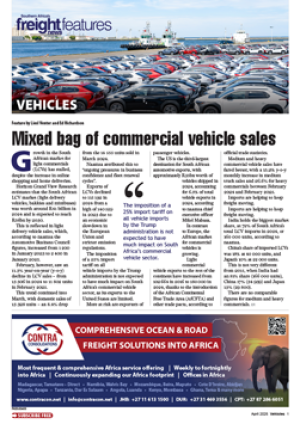WHAT IS the role of ISO certification in the freight industry today? Birkart Globistics, Cargocare, Rail Road Africa, FH Bertling and Namport are among the industry’s strong proponents of the concept. Business consultant Chris Richards offers an overview of the new versus the old standards. At a BVQI course I attended way back in September 2000, delegates were informed that the revision of the ISO 9000 family of standards taking place at the time would: l adopt a process approach l introduce the requirement for continual improvement l need to be user friendly l recognise the needs of stakeholders l provide for compatibility with other management systems The question of interest is whether the revision places any significant additional “burdens” on a company? And let’s face it, if the forwarding industry management did not consider ISO a burden, there would be many more certified agents around. ISO 9001 requires top management to provide evidence of its commitment to continually improve the effectiveness of the QMS, by communicating to the organisation the importance of meeting customer requirements, and by establishing quality policy and objectives. The 1994 model requires the supplier’s management with executive responsibility to define and document its quality policy, including objectives, and states that the policy shall be relevant to the needs and expectations of its customers. Is there a difference? One of the “new” words in the ISO lexicon is “measurable”. In the past there was not particular emphasis on measurability. Now one’s quality objectives must be capable of being measured. So, if your objective is to deliver all incoming airfreighted goods, landed over a weekend, by end-of-play on the Monday, you need to monitor this and management must get involved if there is a nonconformity. (An ugly word but part of the ISO vocabulary!) And, may I ask, purely for expressing an oblique point, what management worth its salt would set objectives just for the sake of having them recorded and filed? Better described When comparing the two Codes of Practice, that is, the 1994 and 2000 versions published by the SABS, one will notice that most, if not all of the requirements of the earlier model are contained in the later. Better described, yes. Less work for the user, no. The most glaring difference between the two models is in the measurement of customer satisfaction. ISO 9001 states that the organisation shall monitor information relating to customer perception as to whether it, the organisation, has met the customer’s requirements. And the methods for obtaining and using this information shall be determined. It requires of forwarders to spend money on testing the market as to their competence. It means opening their methods, procedures and performance to external review and criticism. But it needs to be done. What is not different is the continued inclusion of customer complaints as an item for corrective action. And note that the standard calls for a documented procedure in this regard. In a nutshell, there is not a great deal of difference between 1994 and 2000. ISO will not work, and will not produce benefits, unless senior management are deeply committed and involved. This has not changed. Responsibilities may be clearer, and the customer brought better into focus. But the challenge is the same. And the “burden” remains.
Quality objectives must be measurable
09 Dec 2003 - by Staff reporter
0 Comments
FTW - 9 Dec 03
09 Dec 2003
China threatens competitiveness of local tank container industry Major operator places order for 200
09 Dec 2003
09 Dec 2003
09 Dec 2003
09 Dec 2003
09 Dec 2003
09 Dec 2003
Border Beat
Featured Jobs
New
New
